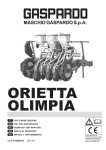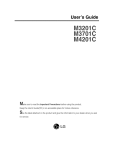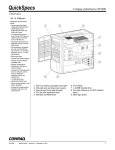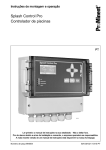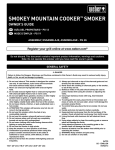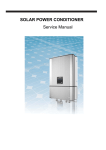Download winter storms - University of Wisconsin
Transcript
winter storms Winter Storm Preparedness and Response SAFETY AT HOME AND WHILE TRAVELING BE AWARE OF THE FORECAST Winter storms are worth serious consideration in Wisconsin. Blizzards, heavy snow, freezing rain and sub-zero temperatures hit hard and frequently across the state. Even if you think you are safe and warm at home, a winter storm can become dangerous if the power is cut off. With a little planning, you can protect yourself and your family from the many hazards of winter weather, both at home and on the road. ♦ Winter weather advisory. Formerly called a “travelers' advisory,” this alert may be issued by the National Weather Service for a variety of severe conditions. Weather advisories may be announced for snow, blowing and drifting snow, freezing drizzle, freezing rain (when less than ice storm conditions are expected), or a combination of weather events. ♦ Winter storm watch. Severe winter weather conditions may affect your area (freezing rain, sleet or heavy snow may occur either separately or in combination). ♦ Winter storm warning. Severe winter weather conditions are imminent. ♦ Freezing rain or freezing drizzle. Rain or drizzle is likely to freeze upon impact, resulting in a coating of ice glaze on roads and all other exposed objects. ♦ Sleet. Small particles of ice, usually mixed with rain. If enough sleet accumulates on the ground, it makes travel hazardous. ♦ Blizzard warning. Sustained wind speeds of at least 35 miles per hour are accompanied by considerable falling and/or blowing snow. This is the most perilous winter storm, with visibility dangerously restricted. ♦ Wind chill. A strong wind combined with a temperature slightly below freezing can have the same chilling effect as a temperature nearly 50 degrees lower in a calm atmosphere. The combined cooling power of the wind and temperature on exposed flesh is called the wind-chill factor. BE PREPARED AT HOME ♦ Keep a battery-powered radio and flashlights in working order; stock extra batteries. ♦ Store food that can be prepared without an electric or gas stove. ♦ Stock emergency water and cooking supplies. ♦ Have candles and matches available in case of a power outage. ♦ Have sufficient heating fuel; regular fuel sources may be cut off. ♦ Have some kind of emergency heating equipment and fuel (a kerosene heater, a gas fireplace or wood-burning stove or fireplace) so you can keep at least one room of your house warm if power is cut off. (See the fact sheet “Staying Warm in an Unheated House.”) University of Wisconsin-Extension • Cooperative Extension more information IF STRANDED ON THE ROAD BE PREPARED IN YOUR CAR If your vehicle becomes stalled or stopped in a winter storm, follow these tips until help arrives. Keep your car “winterized” with antifreeze. Carry a winter car kit that includes a windshield scraper, flashlight, candle and matches, tow chain or rope, shovel, tire chains, blanket, extra mittens, bag of sand or salt, a fluorescent distress flag and an emergency flare. ♦ Keep calm and stay in your vehicle. Do not attempt to walk out of a blizzard. You are much more likely to be found by staying in your vehicle. ♦ Keep fresh air in your vehicle — especially if you are using a candle, solid fuel or other type of heating device — to prevent carbon monoxide build-up and oxygen starvation. ♦ Run motor and heater sparingly and only with the down-wind window open for ventilation. Make sure snow has not blocked the exhaust pipe. ♦ Turn on dome light at night. This helps make the vehicle visible for work crews. ♦ Keep watch. Do not permit all occupants to sleep at once. ♦ Exercise. Clapping hands and moving arms and legs vigorously will help keep you awake and improve circulation. Additional resources: The National Weather Service and local radio stations, your county family living agent, the Wisconsin Division of Emergency Government, the Federal Emergency Management Agency RIDING OUT A STORM AT HOME If you are isolated at home, listen to the radio or television for updates on weather conditions. Conserve fuel by keeping your house cooler than usual and by temporarily “closing off” heat to some rooms. When emergency heating methods must be used, maintain adequate ventilation to avoid build-up of toxic fumes. (See the fact sheet, “Staying Warm in an Unheated House.”) Dress accordingly. Layer your clothing; many layers of thin clothing are warmer than single layers of thick clothing. If you need to go outdoors or the heat is off indoors, wear mittens; they are warmer than gloves. Wear a hat; most body heat is lost through the top of the head. Cover your mouth with scarves to protect your lungs from directly inhaling extremely cold air. If shoveling snow isn't critical, don't do it. If you must shovel snow, take your time and lift small amounts. Over-exertion can bring on a heart attack — a major cause of death during and after winter storms. IF TRAVELING IN BAD WEATHER ♦ Use public transportation, if possible. Try not to travel alone during a storm. ♦ Make sure your vehicle is in good operating condition, winterized, properly serviced and equipped with snow or all weather tires. Be sure your headlights, taillights and windows are clean so you can see and be seen. ♦ Listen to your radio for weather information. ♦ Always fill your gas tank before entering open country, even for short distances. You are less likely to get stranded with a full tank. If you do get stranded, you will have enough gas to run the motor and heat the vehicle. ♦ Let someone know your departure time, expected arrival time and route. ♦ Seek shelter immediately if the storm seems severe. Don't be foolhardy. ♦ Drive carefully and defensively. Don't try to save time by traveling faster than road and weather conditions permit. ♦ Never carry spare fuel inside the vehicle or the trunk. Gasoline fumes can build up and cause a violent explosion. Related publications: “Winter Travel Awareness,” Information from: University of Wisconsin Cooperative Extension, Federal Emergency Management Agency, Wisconsin Division of Emergency Government University of Wisconsin-Extension • Cooperative Extension Protecting Plumbing During a Winter Storm CARE OF UTILITIES AND APPLIANCES WHEN THE POWER IS OUT REDUCE THE CHANCE OF FROZEN PIPES If the heat will be off in your home for several days during a winter storm, you should protect exposed plumbing, sewage systems and appliances from freezing and subsequent damage. Frozen pipes could become a problem once the temperature inside the home falls below 40 degrees F. Follow these steps to reduce the chance of pipes freezing during a power failure: If some pipes have frozen, despite the fact that power has returned or exists, there are some simple measures to take. But whenever possible, get an expert for plumbing work or repairs. ♦ Shut off the water at the main valve, or turn off the well pump if it is in the house. ♦ Turn the water heater off. An explosion could result if the heater is left on without water in the system. You will find either an electrical switch or gas valve for shutting off the appliance. ♦ Open all the faucets on the lower level, then the upper level. You may want to collect the water for household use. ♦ Insulate undrainable pipes around their main valves. Use newspaper, blankets or housing insulation. Unlike summer homes and cottages, modern housing is not usually designed for easy winterization. For this reason, you should contact a plumber or other expert if the house will be without heat for an extended period of time. Critical measures include: draining of toilets, water softening units, drain traps, sump pumps, heaters, humidifiers, dishwashers and other appliances that use water. WHEN PIPES FREEZE Under normal circumstances, most of us never have to worry about a frozen water pipe. Our plumbing pipes are on interior walls and are insulated well enough that water does not freeze. But frozen pipes may become a concern if the heat is off or if water pipes run through unheated crawl spaces, floors over garages or in outside walls. If pipes do freeze: ♦ Shut off the water supply and open faucets to the frozen pipes; ♦ Warm them with a heat lamp, blow dryer or portable heater; ♦ Do not use boiling water, propane torches or any open flame to thaw frozen pipes; ♦ Apply only moderate heat and expect to wait for several hours; ♦ Open sink cabinets to let in warm air. University of Wisconsin-Extension • Cooperative Extension WINTER STORMS-HOME PROTECTION more information If pipes have burst before you could take preventive action, immediately turn off their water supply. Try to locate the areas that need repair and call a plumber. LONG-TERM SOLUTIONS The long-term solution for frozen pipes is to provide adequate insulation and heat. Methods may include wrapping pipes with insulation material and installing weather stripping, insulation and heat to the room. A temporary or last resort solution is the use of electric heating tape, which can be wrapped around the pipes and energized when sub-zero weather is predicted. You can also leave faucets connected to exposed pipes trickling when low temperatures are forecasted. If the pipes are under an enclosed sink, open the door and use a fan to blow warm air from the room toward the pipes. Additional resources: Your county family living agent Information from: University of Wisconsin Cooperative Extension, Pennsylvania State University Cooperative Extension Service, North Carolina Cooperative Extension Service University of Wisconsin-Extension • Cooperative Extension Ice Dam Prevention on Roofs SIMPLE WAYS TO ALLEVIATE THE PROBLEM WHEN SEEPAGE HAS ALREADY BEGUN Ice dams occur when a snow-covered roof over the attic is warmer than the eaves — the overhang of a roof. If the roof is warm, it will cause the snow to melt and run under snow along the roof. When the melted snow hits the cooler eaves, it freezes. As ice builds up on eaves, it eventually traps water behind it. The water backs up under shingles and finds its way through seams in the building paper and roof decking to enter the attic and living area. Wallpaper, plaster and paint surfaces may be damaged in the process. Fortunately, there are several ways to remedy the problem. If you have an immediate problem with ice dams, you should remove the snow from the part of the roof directly above the ice dam. This limits the amount of water that can collect behind the dam. ♦ Remove the snow using a roof rake, hoe or push broom. Roof rakes have long handles that allow you to stay on the ground when clearing a single-story roof. You can purchase them at hardware stores. ♦ Avoid using sharp instruments, such as axes, to break channels through the ice. This is likely to cause roof and structure damage. PREVENTION A cooler attic area will help decrease problems with ice dams. Here are two ways to keep attics cool: ♦ Increase insulation in the attic to at least 12 inches. Also, close any thermal shortcuts —openings that allow air to move from the heated part of the house into the attic. Chases around chimneys, plumbing vents, junction boxes for ceiling light fixtures, attic hatches and ceiling fan mounts are common thermal shortcuts. ♦ Create adequate attic ventilation to remove any heat that escapes into the attic. One square foot of free ventilation opening is recommended for every 150 square feet of attic space. Ventilation should be divided between eaves and the house ridge to take advantage of the fact that warm air rises. When installing eave or soffit vents, be sure that the opening is not blocked by insulation. You can do that by installing a cardboard or plastic channel over the insulation lined up with each vent. Additional resources: Your county Extension office Information from: University of Wisconsin Cooperative Extension, Pennsylvania State University Cooperative Extension Service University of Wisconsin-Extension • Cooperative Extension WINTER STORMS-HOME PROTECTION WHEN SEEPAGE HAS ALREADY BEGUN Ice dams occur when a snow-covered roof over the attic is warmer than the eaves — the overhang of a roof. If the roof is warm, it will cause the snow to melt and run under snow along the roof. When the melted snow hits the cooler eaves, it freezes. As ice builds up on eaves, it eventually traps water behind it. The water backs up under shingles and finds its way through seams in the building paper and roof decking to enter the attic and living area. Wallpaper, plaster and paint surfaces may be damaged in the process. Fortunately, there are several ways to remedy the problem. If you have an immediate problem with ice dams, you should remove the snow from the part of the roof directly above the ice dam. This limits the amount of water that can collect behind the dam. ♦ Remove the snow using a roof rake, hoe or push broom. Roof rakes have long handles that allow you to stay on the ground when clearing a single-story roof. You can purchase them at hardware stores. ♦ Avoid using sharp instruments, such as axes, to break channels through the ice. This is likely to cause roof and structure damage. PREVENTION A cooler attic area will help decrease problems with ice dams. Here are two ways to keep attics cool: ♦ Increase insulation in the attic to at least 12 inches. Also, close any thermal shortcuts —openings that allow air to move from the heated part of the house into the attic. Chases around chimneys, plumbing vents, junction boxes for ceiling light fixtures, attic hatches and ceiling fan mounts are common thermal shortcuts. ♦ Create adequate attic ventilation to remove any heat that escapes into the attic. One square foot of free ventilation opening is recommended for every 150 square feet of attic space. Ventilation should be divided between eaves and the house ridge to take advantage of the fact that warm air rises. When installing eave or soffit vents, be sure that the opening is not blocked by insulation. You can do that by installing a cardboard or plastic channel over the insulation lined up with each vent. Additional resources: Your county Extension office Information from: University of Wisconsin Cooperative Extension, Pennsylvania State University Cooperative Extension Service University of Wisconsin-Extension • Cooperative Extension WINTER STORMS-HOME PROTECTION Staying Warm in an Unheated House COPING WITH A POWER OUTAGE IN WINTER THINK “SAFETY FIRST” During severe winter storms, your home heating system could be inoperative for as long as several days. To minimize discomfort and possible health problems during this time, conserve body heat by dressing warmly; find or improvise an alternative heat source, such as a fireplace or electric space heater; confine heating to a single room; and keep safety a foremost consideration. While chances of freezing to death in your home are small, there's a greater danger of death by fire, lack of oxygen or carbon monoxide poisoning. Safety is of extreme importance in a heating emergency. Follow these precautions: ♦ Do not burn anything larger than candles inside your home without providing adequate ventilation to the outside. ♦ Any type of heater (except electric) should be vented. Connect the stove pipe to a chimney flue if at all possible. (Many older homes have capped pipe thimbles in rooms once heated by stoves.) Or hook up your stove to the flue entrance of the non-functioning furnace pipe. If no other alternative exists, consider extending a stove pipe through a window. Replace the window glass with a metal sheet and run the temporary stove pipe through the metal. ♦ If you use a catalytic or unvented heater, cross-ventilate by opening a window an inch on each side of the room. It is better to let in some cold air than to run the risk of carbon monoxide poisoning. ♦ Do not use a gas or electric oven or surface units for heating. A gas oven may go out or burn inefficiently, leading to carbon monoxide poisoning. An electric oven was not designed for space heating. ♦ Do not burn outdoor barbecue materials such as charcoal briquettes inside — even in a fireplace. ♦ Do not try to use bottled gas in natural gas appliances unless you have converted the appliances for such use. Also, flues and piping suitable for gas burning appliances may be unsafe for use with higher-temperature oil, coal or wood smoke. ♦ Have one person watch for fire whenever alternative heat sources are used. One person should also stay awake to watch for fire and to make sure ventilation is adequate. If the designated person feels drowsy or has a headache, it may be a sign of inadequate ventilation. ♦ Keep firefighting materials on hand. These may include: dry powder fire extinguishers, a tarp or heavy blanket, sand, salt, baking soda and water. CONSERVE BODY HEAT Put on extra clothing. If cold is severe, your bed may be the warmest place. Use extra blankets and coverings to trap body heat; this is an especially good way to keep children warm. Farm families might consider taking refuge in the relative warmth of the livestock barn. University of Wisconsin-Extension • Cooperative Extension WINTER STORMS-HOME/FARM SAFETY more information FIND OR IMPROVISE AN ALTERNATIVE HEAT SOURCE You may have alternative heating resources around your home. Possibilities include: ♦ fireplace, space heater, catalytic camp stove ♦ wood, gas or oil heater ♦ gas-fired hot water heater PROVIDE FUEL Some common materials that could be used for fuel include: ♦ firewood, newspapers, magazines ♦ camp stove fuel, kerosene ♦ wood chips, straw, corncobs You can burn coal in a fireplace or stove if you make a grate to hold it, allowing air to circulate underneath. “Hardware cloth” screening placed on a standard wood grate will keep coal from falling through. Tightly rolled newspapers or magazines can be used as paper “logs.” Stack them as you would stack firewood to allow for air circulation. If the heating situation becomes critical, consider burning wood, including lumber or furniture. SELECT A ROOM TO BE HEATED To increase efficiency of available heat, close off all rooms except the one to be heated. When selecting a room, consider the following: ♦ If using a vented stove or space heater, select a room with a stove or chimney flue. ♦ Confine emergency heat to a small area. ♦ Try to select a room on the “warm” side of the house, away from prevailing winds. Avoid rooms with large windows or uninsulated walls. Interior bathrooms probably have the lowest air leakage and heat loss. Your basement may be a warm place in cold weather because the earth acts as insulation and minimizes heat loss. ♦ Isolate the room from the rest of the house by keeping doors closed, hanging bedding or heavy drapes over entryways, or by erecting temporary partitions of cardboard or plywood. ♦ Hang drapes, bedding or shower curtains over doors and windows, Additional resources: Your county family living agent, your local power company Information from: University of Wisconsin Cooperative Extension, Pennsylvania State University Cooperative Extension Service University of Wisconsin-Extension • Cooperative Extension Winter Power Failure on the Farm KEEPING ANIMALS AND EQUIPMENT SAFE POULTRY AND LIVESTOCK A winter power failure or fuel shortage can cause problems on farms, but being prepared can keep problems to a minimum. Ideally you should have a standby electric generator for emergency power. For ideas on types of generators and their operation, see the fact sheet “Using Standby Electric Generators.” Assuming you have no power, take the following precautions to keep animals and equipment safe. To protect poultry and livestock during a power failure: ♦ Ventilate buildings. Do not close buildings tight to conserve heat, since animals could suffocate from lack of oxygen. Clear ice and snow from all vents because oxygen will eventually be used up in mechanically ventilated production facilities. Then open vents to facilitate natural air flow. ♦ Provide water. All animals, especially cattle, need plenty of water during cold weather. It may be possible to drive your water pump with a small gasoline engine and a belt. Otherwise, you will need to haul water. If you have an outside source of water, cattle can be turned out to drink it. Be sure to place sand or other gritty material on icy feedlots to provide good footing. Whatever the source of water, watch that it remains unfrozen so animals can drink it. ♦ Provide heat. Use camp stoves and heaters as emergency heat sources for brooders. Plan ahead to have this equipment ready when needed. ♦ Provide feed. Animals need extra energy for body heat during severe or prolonged cold weather, especially if they are outside without shelter. Mechanical feeders will be inoperable during a power failure. Provide for emergency feeding procedures. EQUIPMENT Unplug or turn off all electric equipment to prevent damage when power is restored. If you use portable space heaters for supplemental heat, close off the fuel valve as soon as possible after power is interrupted. (On models not equipped with safety shut-offs, and especially on some models with gravity feed fuel systems, fuel continues to flow even when the burner is inoperative. An explosion or fire could result when power is restored.) STORING MILK ♦ Request that the dairy pick up milk as soon as possible. ♦ Consider adding a standby power generator to handle vital electric equipment. University of Wisconsin-Extension • Cooperative Extension WINTER STORMS-HOME/FARM SAFETY more information Even if you are short of extra milk storage facilities, do not store milk in stock tanks or other containers. Dairy plants may not accept milk that has been stored in anything other than regular milk storage containers. Check with your local dairy about policy regarding emergency storage of milk. If you are unable to cool your milk or have it picked up, check your tank for souring each time you add milk to it. This check could mean the difference between losing all or only part of your milk supply. Additional resources: Your county agricultural agent Information from: University of Wisconsin Cooperative Extension, Pennsylvania State University Cooperative Extension Service University of Wisconsin-Extension • Cooperative Extension Animal Safety in Winter PROVIDING ADEQUATE SHELTER, FEED AND WATER PROVIDE SHELTER For animals normally kept outside during the winter, safety can be a concern during extended periods of severe cold, snow or wet conditions. Wind coupled with severe or prolonged cold weather causes additional stress on livestock, increasing their needs for shelter, food and water. Severe cold alone usually will not affect the performance of large animals on full feed. Wind, however, can be a serious stress factor. A strong wind has about the same effect on animals as exposure to a sudden drop in temperature. In general, a 20 mph wind is about equivalent to a 30 degree F. drop in temperature. Under extreme conditions, simple wind and snow protection devices will not be 100 percent effective. Move stock, especially the young, into sheltered areas during severe periods of cold. Adequate shelter is important because animals' extremities are subject to freezing during sub-zero weather. Extremities that become wet or are normally wet are particularly subject to frostbite and freezing. The loss of ears or tails could be of little economic significance, but damage to male reproductive organs could impair the animals' fertility or ability to breed. Frozen and chapped teats will impact milk production. ♦ Shallow open-front sheds provide excellent shelters for livestock. Such shelters should have slots along the eaves on the back side. The openings provide ventilation and prevent snow from swirling into the front of the shed. Use a 1-inch slot per 10 feet of building width. Continuous ridge openings of 2 inches also are recommended for each 10 feet of building width. ♦ Solid-sided feed wagons work well for temporary wind protection. Attach plywood or locate bales of straw or feed at the bottom of the wagon to block wind from moving under the wagon. ♦ Windbreaks, properly oriented and laid out, or timber-covered lowlands make good protection for range cattle. Unlike shed-type shelters, windbreaks eliminate concerns about overcrowding or proper ventilation. ♦ Never close shelters tightly, since stock could suffocate from lack of oxygen. ♦ Additional bedding is helpful to keep animals insulated from the ground and to keep them dry during cold periods. PROVIDE EXTRA FEED During severe or prolonged cold weather, animals need extra feed to provide body heat and to maintain production weight gains. Provide them University of Wisconsin-Extension • Cooperative Extension WINTER STORMS-HOME/FARM SAFETY more information with additional, higher fiber feeds such as hay or hay mixed with oat straw. A good formula during cold weather is to increase feed 1 percent for every degree drop in temperature below 32 degrees F. For example, when the temperature drops from 32 degrees F. to 0 degrees, provide 32 percent more feed (break this into three or four feedings a day). Usually, animals instinctively eat more feed if a storm is approaching. Remember that mechanized feeders may be inoperable during power failures. Unless you have a source of emergency power, you may need extra labor to feed, water and care for animals by hand. PROVIDE WATER Dehydration is often a greater hazard during winter storms than cold or suffocation. Cattle cannot lick enough snow to satisfy their water requirements. They also will need more water if they are eating a higher-fiber diet. Use heaters in water tanks to provide livestock with enough water. Or, only pump out as much water as needed twice a day, to avoid problems with freezing water. If pipes freeze or power is out, you may need to haul water to animals. WATCH YOUR LIVESTOCK Watch your livestock carefully during winter storms and periods of severe cold. Keep them moving. If you see them shivering, not moving or acting abnormally, call your veterinarian. In particular, watch younger cattle for signs of trouble. Additional resources: Your county agricultural agent, the National Weather Service for livestock safety warnings Information from: University of Wisconsin Cooperative Extension, Pennsylvania State University Cooperative Extension Service University of Wisconsin-Extension • Cooperative Extension Standby Electric Generators A SOURCE OF EMERGENCY POWER FOR FARMERS TYPES OF GENERATORS An emergency source of power is important for any farm with mechanically ventilated production facilities, bulk milk handling equipment, mechanical feeding equipment or facilities requiring constant and continuous heat (such as brooders). On such a farm, a standby electric generator is a good investment, possibly preventing costly losses during a power failure. Standby generators are either engine driven or tractor driven. Either type can be stationary or portable. Engine driven units can be either manual or automatic start. Gasoline-, LP gas- (bottled gas) and diesel-fueled engines are available. During disasters such as flood or tornado, relief agencies may provide generators to farmers on an emergency basis. SIZE OF GENERATORS Generators must provide the same type of power at the same voltage and frequency as that supplied by power lines. This is usually 120/240 volt, single phase, 60 cycle alternating current (AC). An air-cooled engine is often used for generators up to 15 kilowatts. A liquid-cooled engine is necessary for generators larger than 15 kilowatts. Engine capacity of 2 to 2 1/4 hp with the proper drive system must be available for each 1,000 watts of generator output. A full-load system will handle the entire farmstead load. Automatic engine-powered, full-load systems will begin to furnish power immediately, or up to 30 seconds after power is off. Smaller and less expensive part-load systems may be enough to handle essential equipment during an emergency. Power-take-off (PTO) generators are about half as costly as engine-operated units. Under a part-load system, only the most essential equipment is operated at one time. For most farms, this type of system is adequate, provided the generator is sized to start the largest motor. For example, the milk cooler or ventilation fan would need to be operated continuously, but the operation of the silo unloader and mechanical feeding system could be postponed until the milking chores are completed. PTO units can be mounted on a trailer. INSTALLATION Wiring and equipment must be installed in accordance with the National Electrical Code, local ordinances and the requirements of your power supplier. It is essential that you have the proper equipment for disconnecting the generator from public utility lines. Most companies require the installation of a double-pole double-throw transfer switch or its equivalent for this purpose. Check with your electrician or power supply representative for installation, installation instructions and inspection. University of Wisconsin-Extension • Cooperative Extension WINTER STORMS-HOME/FARM SAFETY more information LOCATION AND SAFETY FEATURES ♦ Large engine generators should be located in a building, preferably a heated building. ♦ Inlet and outlet air ducts must be large enough to carry off excess heat. They should be open at least a half a square foot for each 1,000 watts of generator capacity. ♦ Combustion fumes must be carried outdoors safely. Exhaust pipes must be at least 6 inches from combustible material. OPERATION An automatic standby unit should start automatically when power fails, and stop when power is restored. When using an engine-driven generator with a manual start, or when using a tractor driven unit, follow this procedure when power fails: ♦ Call your power supplier and advise them of the conditions. ♦ Turn off or disconnect all electrical equipment. ♦ Position the tractor or engine for belt of PTO drive. ♦ Start the unit and bring the generator up to proper speed (1,800 or 3,600 rps). Check on arrangement to carry off exhaust fumes. Be sure there is no danger of fire. The voltmeter will indicate when the generator is ready to carry the load. ♦ Put the transfer switch in the generator position. ♦ Start the largest electrical motor first, adding other loads when each is up to operating speed. Do not add too much too fast. If the generator cuts out for any reason, repeat the second, third and fourth steps above. ♦ Check the voltmeter frequently. If voltage falls below 200 volts for 240 volt service or below 100 volts for 120 volt service, reduce the load on the generator by turning off some electrical equipment. ♦ When commercial power is restored, put the transfer switch in normal power position. Then stop the standby unit. Additional resources: Your county agricultural agent Related publications: UW-Extension publications– “Standby Electric Power Equipment for the Farm and Home,” (AF2273); “Electrical Systems for Agricultural Buildings,” (checklist), (A8NE846); “Electrical Systems for Agricultural Buildings,” (recommended practices), (A8NE845). “Standby Power,” Illinois Farm Electrification Council, Fact Sheet #2. MAINTENANCE ♦ Keep the unit clean and in good running order at all times so it will be ready for immediate use. Dust and dirt accumulations on the motor can cause it to overheat when operated. ♦ Follow maintenance instructions in manufacturer's manual. A short operation at set intervals will keep the engine in good operating condition. Regularly scheduled warm-ups are necessary to keep a standby engine in working order. Information from: University of Wisconsin Cooperative Extension, Pennsylvania State University Cooperative Extension Service University of Wisconsin-Extension • Cooperative Extension Winter Kill of Alfalfa PROMOTING WINTER HARDINESS AND MANAGING DAMAGE PREVENTION OF WINTER KILL Winter kill of alfalfa cannot be avoided entirely in a bad year, but you can minimize its destruction with good manage-ment practices. Frequency of cutting, date of last cutting, and fertilizing are all factors you can control before the first freeze. Once damage is done, careful assessment of your stands can increase your success with reseeding. Contributors to winter kill include low temperatures, ice cover and repeated freezing and thawing. When repeated freezing and thawing cause ice heave, the crown of the plant is forced out of the soil and alfalfa roots may break. Disease also is a contributor to winter kill. The weather conditions described above can lead to disease; but conversely, stands that already are diseased are more susceptible to winter kill. Typical diseases include bacterial wilt, fusarium wilt, phytophthora and root rot. Factors affecting winter kill include: ♦ Age of the stand. The younger the stand, the greater its winter hardiness. ♦ Alfalfa variety. Varieties can make a difference; choose proven winter hardy varieties. For up-to-date information, see the annual Cooperative Extension publication, “Forage Variety Update for Wisconsin.” ♦ Soil fertility. High soil fertility can minimize the chances of winter kill. Use a soil test to be sure potassium levels are in the optimum range. A fall application of fertilizer can be helpful. Adjust fertilizers for the amount of annual growth. ♦ Cutting frequency for the previous season. The more frequently stands are cut, the more susceptible they are to winter kill. Try to let the alfalfa mature to 10 percent bloom at one harvest to rebuild the stand condition. ♦ Date of last fall cutting. A late fall cutting is not recommended, particularly if you cut frequently during the season. If possible, take your last cutting before Sept. 1. If you must cut late in the season, try to cut high (leaving 6 to 8 inches of stubble). This leaves a layer of insulation for the crown. The higher stems also can reduce suffocation when ice cover is a problem. ♦ The amount of growth prior to killing frost. The greater the growth, the better the chance of survival. ASSESSING STANDS IN SPRING After frost is out, inspect alfalfa plants for root and crown condition. If plant roots are not fleshy or off-white, plants are dead or dying. If plants have considerable crown or root rot, they are likely to die. However, keep in mind that after the first year of growth, all plants will show some signs of crown rot; therefore, look for degree of severity. University of Wisconsin-Extension • Cooperative Extension WINTER STORMS-SALVAGING PLANTS/TREES more information Compare stands to the following chart: STAND DENSITY REQUIRED First year after seeding Second year after seeding Third year after seeding FOR MAXIMUM YIELD 20-25 per square foot 12-15 per square foot 6-8 per square foot If plant counts are significantly less than those in the chart, expect reduced yields and increased weed problems. You may need to plow damaged areas down and reseed. But keep in mind your first assessment is preliminary; it is only intended to eliminate the worst stands. The final assessment cannot be made until after plants begin to green up. Some stands are weakened and show injury in spring. Others look healthy at first, but die later in the spring. CONSIDERATIONS FOR RESEEDING Your reseeding options vary depending upon age of stands and when winter kill occurred. If winter kill occurred in early winter, you have more options for reseeding because there will be less autotoxicity in plants. Autotoxicity is caused by an accumulation of one or more compounds that inhibit germination and growth of new alfalfa seedlings. It is found in old stands of alfalfa. Since it takes time for the autotoxic factor to degrade, stands killed in early winter may have less autotoxicity than those killed in spring. Additional resources: Your county agricultural agent Related publications: UW-Extension publications– “Alfalfa Management Guide,” (A3550); “Forage Variety Update for Wisconsin,” (A1525). ♦ If stands were seeded last year, disk to destroy remaining plants in affected areas of the field and reseed alfalfa at a rate of 12 pounds per acre. Use a variety with a high level of resistance (HR) to phytophthora root rot and one that has been treated with the fungicide Apron. It may be possible to reseed only affected areas of the field. ♦ If stands were seeded two years ago, autotoxicity may be a problem. If kill occurred in early winter, reseed as directed above. If kill occurred toward spring or date of kill is unknown, disk areas to be reseeded and wait two to three weeks before reseeding. Use an Apron-treated alfalfa variety with a high level of resistance (HR) to phytophthora root rot. ♦ If stands were seeded three years ago or more, reseeding success is likely to be reduced by autotoxicity. If stand kill occurred early in winter, till areas to be reseeded and wait two to three weeks before seeding. Use an Apron-treated alfalfa variety with a high level of resistance (HR) to phytophthora root rot. The best option is to interseed with red clover at 8 pounds per acre or with an annual or perennial ryegrass at a seeding rate of 8 to 15 pounds per acre, depending on density of remaining alfalfa stand. If winter kill occurred in spring, consider seeding another crop, such as a grain or annual forage like sorghum-sudan grass. Then reseed alfalfa in August or next year. Information from: University of Wisconsin Cooperative Extension University of Wisconsin-Extension • Cooperative Extension Winter Kill of Small Grains PROMOTING WINTER HARDINESS AND MANAGING DAMAGE PLANTING GUIDELINES FOR THE FALL Unstable winter temperatures and lack of snow cover take most of the blame for winter kill of small grains. But other variables play a part as well. Two major factors are planting dates and the grain varieties used. Generally, early planting yields more winter hardiness, better stands and higher yields. Grain varieties with excellent winter hardiness can make a big difference for growers as well. Despite your best efforts, however, winter kill may cause serious damage. If stands are thin, you have several options, ranging from fertilizing to replanting to applying for disaster payments. ♦ Test soil to determine fertility of field. ♦ Control perennial weeds, such as quackgrass. ♦ Use good tillage practices. ♦ Fertilize to a yield goal of 100 to 150 bushels per acre. a) Use nitrogen at 25 lb. per acre. b) Use phosphorous and potassium at high levels prior to planting. ♦ Select a variety with the highest yield for your area, as well as good winter hardiness. Consult with your county Extension office for current data as necessary. Public winter wheat varieties Glacier and Merrimac, for example, are rated “excellent” for winter hardiness in Wisconsin; Cardinal, Caldwell and Howell are rated “good.” ♦ Plant at the optimum date for your area, considering location and likelihood of aphid infestation. For high winter hardy varieties like Glacier and Merrimac, for example, planting dates are: a) Sept. 15-Oct. 10 in southern Wisconsin. b) Sept. 10-Oct. 5 in central Wisconsin. c) Sept.1-20 in northern Wisconsin. Planting dates for varieties with medium winter hardiness, such as Cardinal, Caldwell and Howell, are: a) Sept. 1-15 in southern Wisconsin. b) Aug. 25-Sept. 15 in central Wisconsin. c) Aug. 20-Sept. 10 in northern Wisconsin. Plant in 4- to 7-inch row spacings, incorporating tramlines for subsequent management practices. ♦ Plant 30 to 40 seeds per square foot. ASSESSING THE STAND IN SPRING ♦ Check stand density in the spring as soon as winter survival can be rated. a) If stand is adequate (more than 18 plants per foot of row), apply 25 lb. of nitrogen per acre just prior to or at tillering time (Growth Stage 20). University of Wisconsin-Extension • Cooperative Extension WINTER STORMS-SALVAGING PLANTS/TREES more information b) If stand is poor (fewer than 18 plants per foot of row), apply up to 50 lb. of nitrogen to promote tillering. ♦ Use proper weed control measures if weeds are anticipated to be a problem. ♦ Apply an additional 50 to 75 pounds of nitrogen at stem elongation (Growth Stage 30) for grain filling. ♦ Apply fungicides as needed for disease control during the growing season. ♦ Harvest on time at optimum grain moisture. ♦ Provide for adequate, safe storage space. COMMON QUESTIONS Additional resources: Your county agricultural agent Related publications: ♦ When isn't a crop worth saving? If you see fewer than six plants per square foot, consider ripping them up and replanting something else, such as spring wheat, barley or oats. ♦ Should you interseed spring wheat if the stand is poor? Generally, the disadvantages of interseeding outweigh the advantages. For one thing, differences in maturation rates mean harvest loss and and a lesser quality of wheat. Secondly, hard-red spring wheats and soft-red winter wheats are used in different ways, making them difficult to sell as a mixed-class wheat. If you plan to use the crop for feed, however, this is not a serious concern. ♦ Should you claim a loss through the Agricultural Stabilization and Conservation Service (ASCS)? If you are enrolled in the wheat program and you had major damage from winter kill, this may be the best solution. Consult with your county agricultural agent and ASCS personnel if you need help making this decision. If the claim is approved you may be able to collect a disaster payment, replant spring small grains or corn and still protect your wheat base. ♦ What weather conditions will increase the chances of winter kill? a) A rapid drop in temperature in the fall instead of a gradual drop. This will increase chances of winter kill because plants don't have time to develop winter hardiness. b) Lack of snow cover and repeated warming and freezing. These conditions occur frequently in the months of February and March. In some cases, plants will break dormancy and start growing before winter conditions have ended. In other cases, plants may be smothered by ice sheets, ponding and flooding that develop. UW-Extension publication “Small Grain Varieties for Grain and Forage in Wisconsin,” (A3397). Information from: University of Wisconsin Cooperative Extension University of Wisconsin-Extension • Cooperative Extension




















